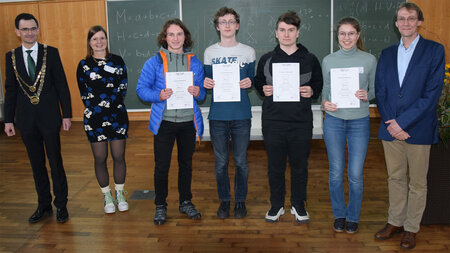Relaxing Embedded Curves
In general, the elastic flow of curves does not preserve the isotopy type of the initial configuration. Regularizing the bending energy by a small factor of a self-avoiding functional leads to situations close to self-contact. In order to avoid technical issues, we replace ropelength by a smooth functional.
Tangent-point potential
The tangent-point potential has been introduced by Gonzalez and Maddocks [GM] and investigated by Strzelecki and von der Mosel [SvdM]. It amounts to
Numerical simulation
The discretization of
In [BaR] we consider a numerical scheme for the
Experiments like the simulation shown on this page indicate a complex energy landscape.
Symmetry
Prescribing symmetry yields different evolutions and limit objects which are referred to as symmetric elastic knots, see [GiRvdM].
In the example shown on the left, we consider
The situation for more general knot classes and symmetries is wide open.
References
| [BFS] | Sören Bartels, Philipp Falk, Pascal Weyer. KNOTevolve – a tool for relaxing knots and inextensible curves. Web application, 2020. [ link ] |
| [BaR] | Sören Bartels and Philipp Reiter. Stability of a simple scheme for the approximation of elastic knots and self-avoiding inextensible curves. Accepted for publication by Mathematics of Computation, 2021. [ arXiv | doi ] |
| [BlR] | Simon Blatt and Philipp Reiter. Regularity theory for tangent-point energies: The non-degenerate sub-critical case. Adv. Calc. Var., 8(2):93–116, 2015. [ arXiv | doi ] |
| [BRR] | Sören Bartels, Philipp Reiter, and Johannes Riege. A simple scheme for the approximation of self-avoiding inextensible curves. IMA Journal of Numerical Analysis, 2017. [ preprint | doi ] |
| [GM] | Oscar Gonzalez and John Maddocks. Global curvature, thickness, and the ideal shapes of knots. Proc. Natl. Acad. Sci. USA, 96(9):4769–4773 (electronic), 1999. [ open access ] |
| [GiRvdM] | Alexandra Gilsbach, Philipp Reiter, Heiko von der Mosel. Symmetric elastic knots. Preprint 2021. [ arXiv ] |
| [SvdM] | Paweł Strzelecki and Heiko von der Mosel. Tangent-point self-avoidance energies for curves. J. Knot Theory Ramifications, 21(5):1250044, 2012. [ arXiv | doi ] |




